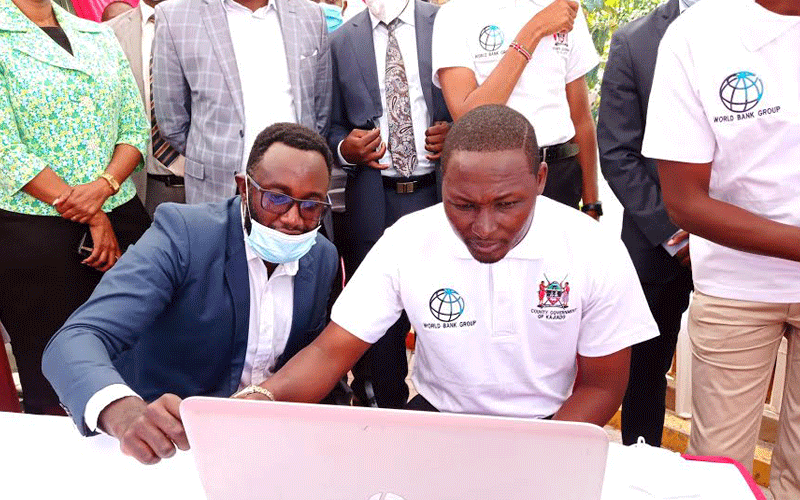New system to help Kajiado speed up project approvals

Milliam Murigi @millymur1
Land buyers, investors and residents of Kajiado county will now enjoy enhanced efficiency and transparency while undertaking land transactions, thanks to a new electronic development permitting system launched this week.
Dubbed Kajiado Electronic Development Application Management System (KeDAMS), this web-based Management Information System (MIS) software will automate development applications in the county, eliminating physical documents.
The county has experienced rapid urbanisation, considering its proximity to the capital city with a rise in major towns, such as Ngong, Ongata Rongai, Kiserian, Kitengela among others hosting a large population.
The rise in urbanisation has continued to attract large investments in real estate to provide for housing, educational institutions and industrial facilities.
The transformed land use across the country, therefore, calls for the deployment of technology to support the key function of physical planning and construction permitting.
Kajiado deputy governor Martin Moshisho said introduction of the system is a big win for the county because automation of end-to-end development control processes will reduce backlog in development, permit approval and issuance, fill all the loopholes available thus increasing construction activities across the county.
“Development permits are not just random administrative requirements, but are particularly important to generate more wealth, attract investment and ensure a better protection of the environment and the community,” said Moshisho.
The system developed by the department of Land, Housing and Physical Planning and Urban Development, the county government in partnership with the World Bank and Architectural Association of (AAK) is the fourth to be deployed in the country after Nairobi, Kiambu and Kisumu.
It is poised to improve the efficiency of construction permitting, enhance communication between consultants, developers and county technical staff, as well as enhance transparency.
The county government will also have a more robust management oversight tool and it is expected that the increased efficiency will also translate into larger revenue collection.
“With this system, it is now possible to restrict users of the system to only persons who are registered to practice as architects, engineers and town planners,” said Moshisho, adding “This will enhance public safety and bar unqualified persons from conducting business in the county.”
Some of the tasks being automated include among others, development project proposal submissions by planners, architects and engineers, development applications review, issuance of development permits, inspection scheduling and enforcement, issuance of final compliance and occupancy certificates, development fee calculation and automated revenue collection.
Gate keeping role
The system also has additional planning and inspection workflows. Applications, such as change of land use, land sub-division, regularisation for change of land use and subdivision, lease extension, and use applications will be submitted, reviewed, and approved online.
Wilson Mugambi, the AAK Vice president who was present at the launch said the KeDAMS process will play a critical “gate-keeper” role in ensuring all development in the county conforms to the approved zoning requirements.
He revealed that lack of planning enforcement leads to poor oversight on environmental quality, buildings safety and higher costs for the community.
The “gate-keeper” function if not carefully managed and coordinated with the relevant authorities, an insurmountable bureaucracy may emerge, which is likely to discourage investment and increase the level of informality.
“An electronic permitting system typically replaces traditional paper and file-card systems.
As a result, the intent of electronic permitting is to reduce processing time, improve customer service and staff efficiency, enhance quality, and make operating funds more productive,” said Mugambi.
Globally, Kenya was ranked 105 out of 190 economies in the world (World Bank Doing Business 2020 report) on the ease of dealing with construction permits.
Such technologies can be used to reform countries’ development applications management procedures and reduce the processing time and ultimately promote development compliance at the county and country level.Reforms in development control administration continue to take root in various parts of the world.
In 2018/19, 37 economies across the world reformed their construction permit processes.
Key reforms include, implementing electronic platforms for building permit applications, streamlining internal review processes for building permit applications, reducing time to process building permit applications, adopting new building regulations, improving building quality control processes, improving one-stop shops and fees reduction.
Ready to go
And to ensure that the county doesn’t experience the same challenges experienced by its predecessor, such as the system being hacked and easily manipulated, KeDAMS has additional features that make it unhackable.
Additionally, as part of the agreement, the county government will continue to receive post-deployment technical support for one year from the World Bank.
“As a county, we are ready for the transition. Our staff have been thoroughly trained for a year and are well equipped with the knowledge required to operate this system.
They are ready and able to do any type of work related to the system. The only thing they cannot do is that they can’t install the system, but they can operate it,” said Fred Swalah, Director of urban development Kajiado county.
And as a way of ensuring that there is successful transitioning from manual process to digital process, developers and investors who have been eyeing to put up developments in Kajiado have up to January 14, 2021 to familiarise themselves with the new system before the development application goes fully digital.
“As from January 15, all of the above-mentioned services will be available online and there will be no manual submission.
I know some people will object to this move in order to promote crooked ways that will help them thrive in their businesses, but nothing will change this decision,” said Moshisho.
Once the system is fully adopted it will change the way communities across the county will do business, speeding the construction permit process for builders, inspectors and plan reviewers.












